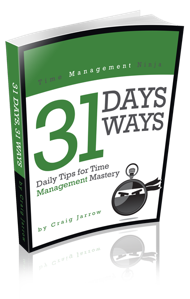
You have a bunch of work projects. So you begin the process of transferring first-steps and ideas to your to-do list.
This might get some projects started, but it might not be the best way to get them completed.
You are missing the big picture. You can’t see how the projects fit in with each other.
To understand the projects better, to be more productive, you must break them down into tasks.
Staging Before Doing
Before you can execute, you need to stage your ideas, sketching out the different components to get a sense of how everything fits together. Staging is almost like a dry run for your planning, where you get to see all of the different pieces out of order. It’s a place to play with your ideas without committing to a specific workflow.
For me, I map everything out in Excel, (some people prefer to sketch on paper; others use a tool like Trello). I set a temporary stage where I can see what my projects look like.
I move items around, break tasks down into smaller tasks, combine some tasks together and eventually all of those disparate projects make sense. I see how they relate to each other. I understand which ones should come first. And I know how and when I should start them all. In other words, now I am ready to start adding things to my list.
This entire process takes less than an hour. And I save myself at least ten times that amount of future effort and backtracking.
Staging allows you to focus not on the specific steps you’ll need to complete, but instead to focus on the bigger picture.
Once you’ve staged your projects, it becomes much easier to get a sense of the specific steps needed to complete them.
Productivity is all about doing. You have goals and projects and you want them completed. But sometimes you get more done by starting your project not with an action or a list, but with a deep breath.
I live off of my to-do list. I use it to track everything in my life. So I’m in the habit of breaking large projects down into smaller, actionable tasks, with the goal of completing all of the tasks required to finish a project.
This works well when you know what you want your final product to be. But there are lots of interesting ideas and projects whose steps to completion might be unknown.
That’s when you need to take a breath and exhale slowly. This is a good time to stage your project. Get down the steps and the goals without thinking too much. Just empty out your brain and start playing with what’s on the page or your screen. Start to put things in order. Start to make sense of the mess. Eventually, actionable steps will emerge from the mental clutter.
Here are five simple steps to staging your project:
- Identify a project (or projects) where you’re unsure of next steps.
- Use your favorite tool to capture everything important about these projects. It’s easiest if they’re goals and steps. Get down everything you can think of.
- Take a quick walk and come back to your staging area. What patterns do you see? How can you make your steps better and more precise?
- Reorganize your staging area so it’s in an actionable order and related tasks are intertwined. Why do the same thing twice if you can do it once?
- Transfer everything to your calendar or to-do list.
Staging Before Planning is More Productive
Staging your project like this feels like a time-waster, but often it’s what you need to figure out the best way to tackle a project. The need to be productive makes us feel like we don’t have even a second to take a breath and consider our next steps. But many times that brief pause is just what our mind needs to sort things out. It’s natural to want to dive in and start scheduling and planning but it can be more productive to start by staging your projects first.
Question: Do you stage your projects before you start? How could staging help you be more productive? You can leave a comment by clicking here. I am the author of Time Management Ninja and help individuals and companies reclaim their time to be more productive. As well, I am the author of the book
I am the author of Time Management Ninja and help individuals and companies reclaim their time to be more productive. As well, I am the author of the book 

One thought on “5 Steps to Stage Your Project and Be More Productive”
Comments are closed.